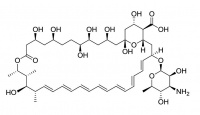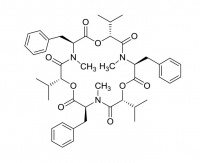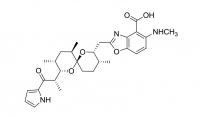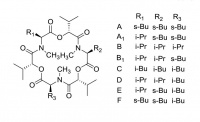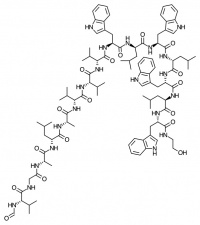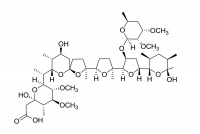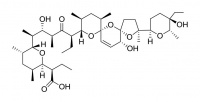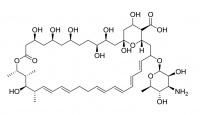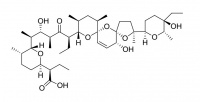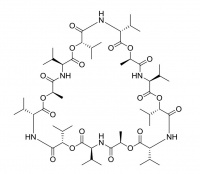Difference between revisions of "Ionophores in Society"
(→Monensin A) |
(→Monensin A) |
||
| Line 139: | Line 139: | ||
[http://en.wikipedia.org/wiki/Monensin Monensin] is used in the livestock industry as a food supplement, where it can alter the gut flora (bacteria populations) of the animal so that animal growth rates are improved. It has also been reported to have anti-tumor properties. | [http://en.wikipedia.org/wiki/Monensin Monensin] is used in the livestock industry as a food supplement, where it can alter the gut flora (bacteria populations) of the animal so that animal growth rates are improved. It has also been reported to have anti-tumor properties. | ||
| − | Dissolve 25 mg in 37.3 mL of solvent to make a 1.00 mM stock solution | + | Dissolve 25 mg in 37.3 mL of solvent to make a 1.00 mM stock solution. |
'''References''' | '''References''' | ||
Revision as of 18:09, 8 August 2013
Ionophores are not only chemically interesting in their own right but have important medical and economic roles in our society.
A selection of ionophores is presented below for study in mainstream chemistry courses as well as courses for pre-med, vet, pharma, biochemistry, and soil and agricultural science students. The demonstration of ion movement across membranes is also relevant to courses on neurophysiology, and biophysics.
The use of ionophore 'growth promoters' in the animal feedstock industry is also of concern to environmental chemists because of their presence in manure and sewerage sludges used as fertiliser for human and animal crops.
The ability of these materials to transport ions across phospholipid bilayer cell membranes, which is usually the key to understanding their mode of action, can be easily studied using tethered membrane technology. A suitable protocol is outlined in Application Note: SDx Protocol 1.
Most of these ionophores can be obtained from eDAQ.
Contents
Amphotericin B
Amphotericin B is an antibiotic used to treat serious fungal infections. It forms ion channels in the fungal cell membrane with the assistance of ergosterol which is a naturally occurring lipid in fungal membranes. As a medicine it is administered intravenously as a liposomal preparation.
While its affinity for ergosterol makes it target fungal cells, Amphotericin can also interact, though to a lesser extent, with the cholesterol in mammalian cells. This limits its therapeutic dosage because of toxicity.
Amphotericin B is similar both in structure and in action to Nystatin.
Dissolve 25 mg in 27.0 mL of solvent to make a 1.00 mM stock solution.
References
- Novel, unifying mechanism for amphotericin B and other polyene drugs: electron affinity, radicals, electron transfer, autoxidation, toxicity, and antifungal action. Peter Kovacic and Andrew Cooksy, Medicinal Chemical Communications, 3, 274-280, 2012. DOI: 10.1039/C2MD00267A
- Drug Information Online.
- Available from eDAQ.
Beauvericin
Beauvericin is closely related to the macrocyclic enniatins, having three benzyl groups in place of the aliphatic chains of the enniatins. It is a potentially toxic agent found in grain crops affected by Fusarium fungi.
Dissolve 25 mg in 31.9 mL of solvent to make a 1.00 mM stock solution.
Reference
- Occurrence of Beauvericin and Enniatins in Wheat Affected by Fusarium avenaceum Head Blight. A Logrieco, A Rizzo, R Ferracane, and A Ritieni, Applied Environmental Microbiology, 68, 82-85, 2002. DOI: 10.1128/AEM.68.1.82-85.2002
- Available from eDAQ.
Calcimycin
The most notable feature of Calcimycin is ability to transport divalent cation across cell membranes. Its in vitro affinity for cations is Ni2+ > Co2+ > Zn2+ > Mn2+ > Mg2+ ~ Ca2+ > Sr2+ > Ba2+, however transport rates across lipsomal membranes are reported as Cd2+ > Zn2+ > Ca2+ > Mg2+ > Sr2+ > Ba2+. Calcimycin is also widely known as Ionophore A23187. It has antibiotic properties, and is also being used in IVF treatments.
Dissolve 5 mg in 9.55 mL of solvent to make a 1.00 mM stock solution.
References
- Structures and Properties of Naturally Occurring Polyether Antibiotics. Jacek Rutkowski and Bogumil Brzezinski, BioMed Research International, Article ID 162513, 2013. DOI: 10.1155/2013/162513
- Equilibria between ionophore A23187 and divalent cations: stability of 1:1 complexes in solutions of 80% methanol/water. CJ Chapman, AK Puri, RW Taylor, DR Pfeiffer, Biochemistry, 26, 5009-5018, 1987. DOI: 10.1021/bi00390a019
- The specificity of ionophore A23187 in cation transport across lipid membranes. Studies with lecithin vesicles. WG Pohl, R Kreikenbohm, K. Seuwen, Z Naturforsch C, 35, 562-568, 1980.
- Ca2+ transport properties of ionophores A23187, ionomycin, and 4-BrA23187 in a well defined model system. W.L. Erdahl, C.J. Chapman, R.W. Taylor and D.R. Pfeiffer, Biophysical Journal, 66, 1678-1693, 1994. 10.1016/S0006-3495(94)80959-2
- Application of a ready-to-use calcium ionophore increases rates of fertilization and pregnancy in severe male factor infertility. Thomas Ebner, Maria Köster, Omar Shebl, Marianne Moser, Hans Van der Ven, Gernot Tews, Markus Montag, Fertility and Sterility, 98, 1432–1437, 2012. DOI: 10.1016/j.fertnstert.2012.07.1134. Free download.
- Available from eDAQ.
Enniatin complex
Enniatins are produced by Fusarium fungi that commonly infect wheat and other grains. High levels are potentially toxic.
A mixture of several closely related macrocylic molecules is commonly encountered. At last count there were 28 enniatins known.
There have also been some reports of Enniantins having promise as antibiotics and anti-cancer drugs.
Dissolve 50 mg in 78.1 mL, or 10 mg in 15.6 mL, of solvent to make a 1.00 mM stock solution.
References
- Occurrence of Beauvericin and Enniatins in Wheat Affected by Fusarium avenaceum Head Blight. A Logrieco, A Rizzo, R Ferracane, and A Ritieni, Applied Environmental Microbiology, 68, 82-85, 2002. DOI: 10.1128/AEM.68.1.82-85.2002
- Toxicology Portal at Toxicology.no.
- Available from eDAQ.
Gramicidin
Gramicidin is used as a topical antibiotic. It is often regarded as the archetypal ion channel despite its unusual dimer arrangement that can form across the cell membrane. It was one of the first commercially available antibiotics and is used today in several topical medications.
Gramicidin is usually sold as a mixture of related linear polypeptides (principally A, B and C) by Sigma-Aldrich and many other suppliers. The main component is Gramicidin A.
Dissolve 100 mg in 53.1 mL of solvent to make a 1.00 mM stock solution.
Gramicidin S is an unusual macrocyclic variant.
Reference
- Structure of gramicidin A. B A Wallace, Biophysics Journal, 49, 295–306, 1986. Free access at PubMed Central: PMC1329637
- Drug Information Online.
- Available from Sigma-Aldrich or Santa Cruz Biotechnology
Lasalocid
Lasalocid is commonly used as an antibiotic for control of coccidiosis, a protozoan parasite of poultry and livestock.
Dissolve 25 mg in 42.3 mL of solvent to make a 1.00 mM stock solution.
References
- Effect of Monensin and Lasalocid-Sodium on the Growth of Methanogenic and Rumen Saccharolytic Bacteria. Min Chen and MJ Wolin, Applied and Environmental Microbiology, 72-77, 1979.
- Trace Level Determination of Polyether Ionophores in Feed. BioMed Research International, 2013, Article ID 151363. Mervi Rokka, Marika Jestoi, and Kimmo Peltonen, DOI: 10.1155/2013/151363
- Rotation programmes for coccidiosis control. Dr H. D. Chapman, International Poultry Production, 15, 7-9, 2007. Free download.
- Drug Information Online.
- Available from eDAQ.
Maduramicin
Maduramicin is used as an antibiotic for control of coccidiosis, a protozoan parasite of poultry and livestock.
Dissolve 25 mg in 27.3 mL of solvent to make a 1.00 mM stock solution.
Reference
- Trace Level Determination of Polyether Ionophores in Feed. BioMed Research International, 2013, Article ID 151363. Mervi Rokka, Marika Jestoi, and Kimmo Peltonen, DOI: 10.1155/2013/151363
- Rotation programmes for coccidiosis control. Dr H. D. Chapman, International Poultry Production, 15, 7-9, 2007. Free download.
- Drug Information Online.
- Available from eDAQ.
Monensin A
Monensin is used in the livestock industry as a food supplement, where it can alter the gut flora (bacteria populations) of the animal so that animal growth rates are improved. It has also been reported to have anti-tumor properties.
Dissolve 25 mg in 37.3 mL of solvent to make a 1.00 mM stock solution.
References
- Structure and Antimicrobial Properties of Monensin A and Its Derivatives: Summary of the Achievements Daniel Łowicki and Adam Huczyński, BioMed Research International, Article ID 742149, 2013. DOI: 10.1155/2013/742149
- Effect of Monensin and Lasalocid-Sodium on the Growth of Methanogenic and Rumen Saccharolytic Bacteria. Min Chen and MJ Wolin, Applied and Environmental Microbiology, 72-77, 1979. Free Access at PubMed Central: PMC243437
- Polyether ionophores—promising bioactive molecules for cancer therapy. Adam Huczyński, Bioorganic & Medicinal Chemistry Letters, 22, 7002–7010, 2012. DOI: 10.1016/j.bmcl.2012.09.046
- Trace Level Determination of Polyether Ionophores in Feed. BioMed Research International, 2013, Article ID 151363. Mervi Rokka, Marika Jestoi, and Kimmo Peltonen, DOI: 10.1155/2013/151363
- Rotation programmes for coccidiosis control. Dr H. D. Chapman, International Poultry Production, 15, 7-9, 2007. Free download.
- Hazard Analysis Critical Control Point (HACCP) Manual, Bio Agri Mix LP.
- Drug Information Online.
- Available from eDAQ.
Narasin
Narasin is a methylated derivative of salinomycin, and has similar properties.
Reference
- Trace Level Determination of Polyether Ionophores in Feed. BioMed Research International, 2013, Article ID 151363. Mervi Rokka, Marika Jestoi, and Kimmo Peltonen, DOI: 10.1155/2013/151363
- Rotation programmes for coccidiosis control. Dr H. D. Chapman, International Poultry Production, 15, 7-9, 2007. Free download.
- Drug Information Online.
- Available from eDAQ.
Nystatin
Nystatin is an antifungal antibiotic often prescribed for the treatment of Candida infections. It forms ion channels in the fungal cell membrane with the assistance of ergosterol which is a naturally occurring lipid in fungal membranes. As a medicine Nystatin is taken orally or topically.
While its affinity for ergosterol makes it target fungal cells, it can also interact, though to a lesser extent, with the cholesterol in mammalian cells. This can limit its therapeutic dosage because of toxicity.
It is similar both in structure and in action to Amphotericin B.
References
- Drug Information Online.
- Available from eDAQ.
Salinomycin
Salinomycin is used in the livestock industry as a food supplement, where it can alter the gut flora (bacteria populations) of the animal so that animal growth rates are improved.
It is also being investigated as an anti-cancer agent.
References
- Persistence of antibiotics such as macrolides, tiamulin and salinomycin in soil. Michael P. Schlüsener, Kai Bester, Environmental Pollution, 143, 565–571, 2006. DOI: 10.1016/j.envpol.2005.10.049
- Effects of the veterinary pharmaceutical salinomycin and its formulation on the plant Brassica rapa. V. Furtula, G. L. Stephenson, K. M. Olaveson, P. A. Chambers, Archives of Environmental Contamination and Toxicology, 63, 513-522, 2012. DOI: 10.1007/s00244-012-9807-y
- Polyether ionophores—promising bioactive molecules for cancer therapy. Adam Huczyński, Bioorganic & Medicinal Chemistry Letters, 22, 7002–7010, 2012. DOI: 10.1016/j.bmcl.2012.09.046
- Trace Level Determination of Polyether Ionophores in Feed. BioMed Research International, 2013, Article ID 151363. Mervi Rokka, Marika Jestoi, and Kimmo Peltonen, DOI: 10.1155/2013/151363
- Rotation programmes for coccidiosis control. Dr H. D. Chapman, International Poultry Production, 15, 7-9, 2007. Free download.
- Hazard Analysis Critical Control Point (HACCP) Manual, Bio Agri Mix LP.
- SACOX Product Information Sheet, Invert Inc.
- Drug Information Online.
- Available from eDAQ.
Valinomycin
Valinomycin is a macrocylic polypeptide and is historically one of the best known ionophores, especially for its 104 fold selectivity for potassium over sodium ions. It is being investigated for use as an antibiotic.
It is used in the manufacture of potassium ion selective electrodes.
References
- K+/Na+ Selectivity in K-Channels and Valinomycin: Over-coordination Versus Cavity-size constraints. Sameer Varma, Dubravko Sabo, Susan B. Rempe, Journal of Molecular Biology, 376 13–22, 2008. DOI: 10.1016/j.jmb.2007.11.059. Free Access at PubMed Central: PMC2390915
- Design principles for K+ selectivity in membrane transport. Sameer Varma, David M. Rogers, Lawrence R. Pratt, and Susan B. Rempe, Journal of General Physiology, 137, 479-488, 2011. DOI: 10.1085/jgp.201010579
- Ion-Selective Electrodes With Ionophore-Doped Sensing Membranes, Philippe Bühlmann and Li D. Chen, 2539-2579 in "Supramolecular Chemistry: From Molecules to Nanomaterials", Philip A. Gale and Jonathan W. Steed (Eds), John Wiley & Sons Ltd. 2012. ISBN: 978-0-470-74640-0. Free download.
- Available from eDAQ.
